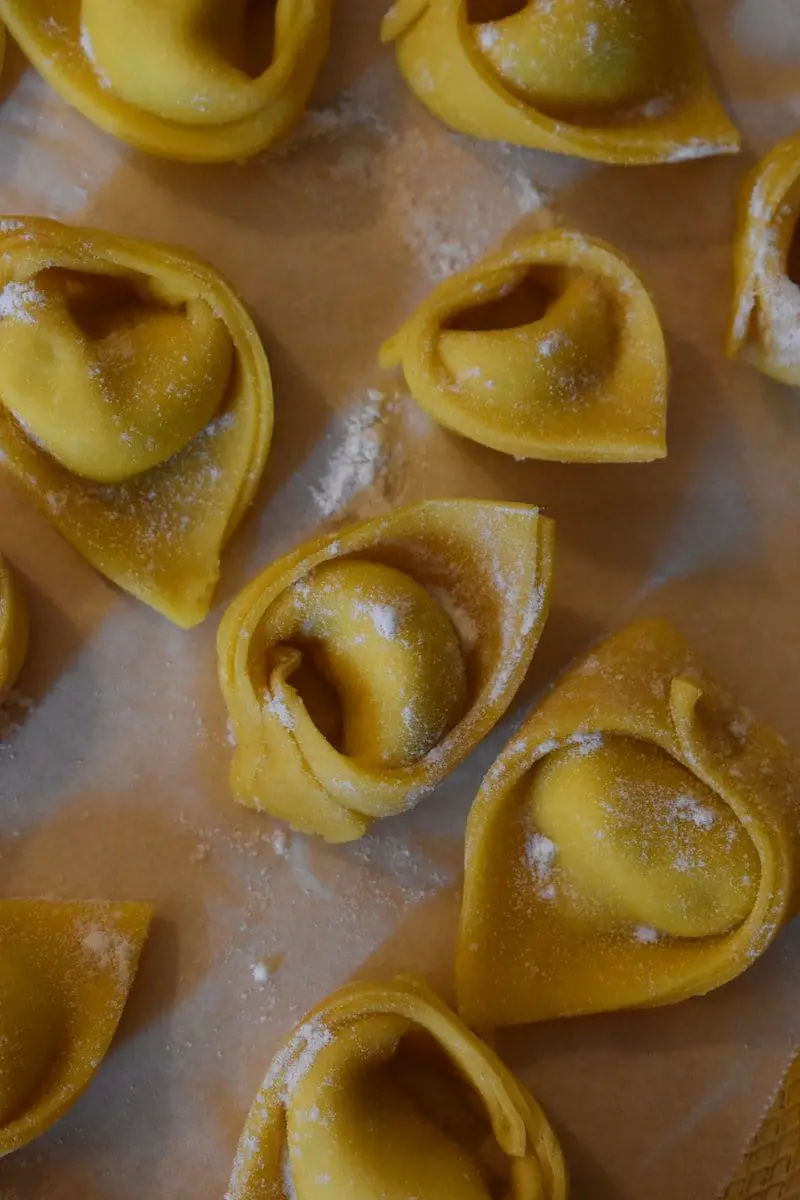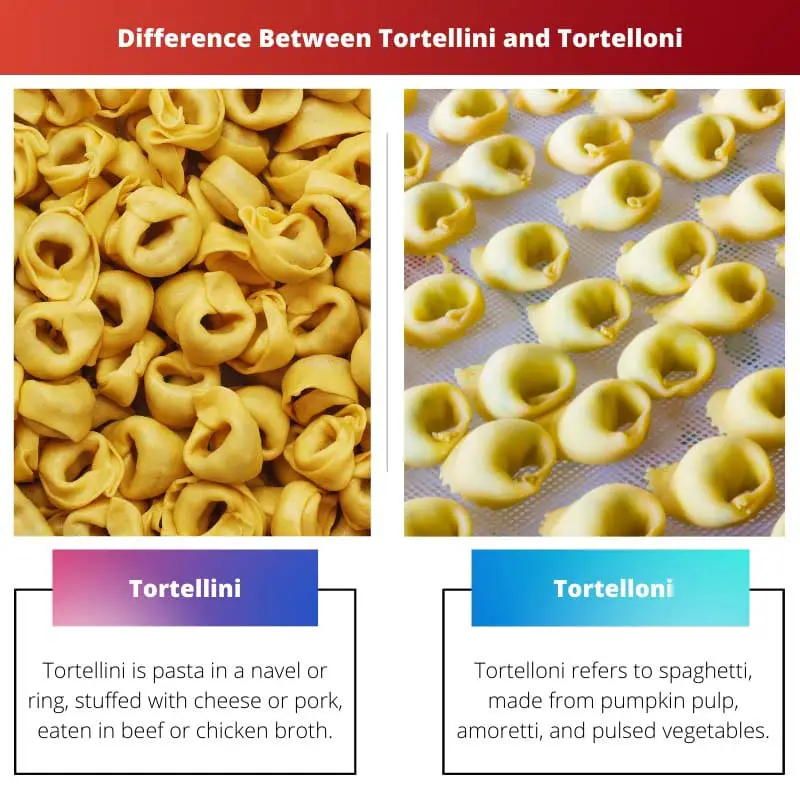Were you aware the two distinct pasta forms are tortellini and Tortelloni? Many people conflate the two or really don’t know that the two pasta names are separated. The names and forms are almost alike, of course.
The thin, full-filled pasta is not the most popular (or written about) Italian food, bought frozen or even ordered as a page from a pizzeria.
It is possible to underestimate the value of food diversity at the local and regional levels. Similar food items have recently been produced in the innovation of different menus.
In various tasty recipes such as tortellini and Tortelloni, pasta, for example, can be adapted to different shapes, sizes, and fillings. While the two share pasta as their main ingredient, their proportions, shapes, fillings, and flavor is distinct in various ways.
Key Takeaways
- Tortellini and tortelloni are both types of Italian pasta that are stuffed with cheese, meat, or vegetables.
- Tortellini is smaller and contains less filling than tortelloni, which is larger and has more filling.
- Tortelloni is served as a main course, while tortellini is served as a soup or appetizer.
Tortellini vs Tortelloni
Tortellini is an Italian pasta with a small ring-like shape. This pasta is served as an appetizer and can be preserved for 7 weeks. It is filled with cheese and meat. Tortelloni is a large spaghetti pasta and it is served as a main meal. It is filled with pumpkins, leaves, etc.

Tortellini is pasta with a form navel or ring that is baked with cheese or meat and eaten with beef or chicken broth, originally from Emilia, an area of Italy. In places with strong Italian populations, it is more prevalent.
While TortelliniTortellini is available in most parts of the world, they have a shelf life of 7 weeks for fresh food. They are good-looking but short.
Tortelloni is less flavorful than tortellini and is larger. It is popular in highly Italian areas and served with leafy, amaretti, pumpkin, or ricotta and melted butter, raga, or salvages. This pasta is used to prepare leafy vegetables.
Comparison Table
| Parameters of Comparison | Tortellini | Tortelloni |
|---|---|---|
| Definition | Tortellini is pasta in a navel or ring, stuffed with cheese or pork, eaten in beef or chicken broth. | Tortelloni refers to spaghetti, made from pumpkin pulp, amoretti, and pulsed vegetables or ricotta and eaten with melted butter, raga, or wise beans. |
| Fillings | Tortellini is filled with cheese or beef. | Tortelloni is filled with leaf, amaretto, pumpkin, and ricotta. |
| Flavor | There’s plenty of taste in Tortellini. | There is less seasoning in tortelloni. |
| Served with | Beef or chicken broth is eaten in Tortellini. | Melted butter, raga, or wild leaves are also used in tortelloni. |
| Size | Small | Large |
What is Tortellini?
Tortellini is crown-shaped pasta, here and there are also “nave shaped,” now their name is chosen as “punch pin.” The meat of the pasta is changed, and the cheddar can be used for day filling with prosciutto, parmesan, and ricotta cheeses.
Tortellini, the wider variety of spaghetti, is filled with cheddar, vegetable products, and meat sauce.
They are filled with a mixture of meat or cheddar. They are served in stock from the Italian district of Emilia, both hamburgers, chicken, or both. As a general rule, ‘Fresh’ stuffed Tortellini is seven weeks long.
Tortellini and Tortelloni are comparatively pressed, cooled, or frozen but still bigger in a number of areas throughout the globe with cheddar and vegetable stuffing.
Particularly where there are huge numbers of Italians, Tortellini, and Tortelloni are manufactured in European mechanical lines supplying markets in Europe and farther away from home.
Nevertheless, some sauces are known as tomatoes, champagne, or meats, but tortellini is Italian crown-shaped spaghetti stuffed with cheddar or hamburger, consumed daily. Tortellini begins in the Emilia-Romagna region of Italy and has a special connection with Bologna.
| # | Preview | Product | |
|---|---|---|---|
| 1 |

| Amazon Fresh, Cheese Tortellini Pasta, 19 Oz | Check Price on Amazon |
| 2 |

| Buitoni Three Cheese Tortellini, 20 Oz | Check Price on Amazon |

What is Tortelloni?
Tortelloni is stuffed spaghetti, which has the same appearance but is bigger than tortellini. Cheesecakes and leafy vegetables like spinach are normally stuffed. There are a large number of versions where stronger ingredients, such as pigs or walnuts, replace vegetables.
A paste made primarily from kitchen pulp and amaretti biscuits is another popular filling agent for Tortelloni, particularly in the province of Modena and Reggio Emilia.
Tortelloni is commonly eaten with ricotta and herbs, either with ragù or with molten butter and salad leaves. Tortelloni is stuffed pasta, popular in northern Italy, with a tortellini-like shape but bigger and with different extremities closed.
Traditionally, they are filled with ricotta and leafy veggies, such as Persil and/or spinach. Variants occur where stronger ingredients such as porcini and walnuts are substituted for vegetables.
The paste made mainly of pumpkin pulp and amaretto biscuits is another popular filling agent for Tortelloni, particularly in the provinces of Ferrara, Modena, and Reggio Emilia.

Main Differences Between Tortellini and Tortelloni
- Tortellini is ring-shaped pasta, whereas Tortelloni stuffed spaghetti has the same appearance but is bigger than tortellini.
- There’s plenty of taste in TortelliniTortellini, whereas there is less seasoning in Tortelloni.
- Tortellini is small in size, whereas Tortelloni is large in size.
- Beef or chicken broth is eaten in TortelliniTortellini, whereas melted butter, ragu, or wild leaves are also used in Tortelloni.
- Tortellini is filled with cheese or beef, whereas Tortelloni is filled with leaf, amaretto, pumpkin, and ricotta.

- https://journals.sagepub.com/doi/abs/10.1177/1367549419861637
- https://www.degruyter.com/document/doi/10.11129/detail.9783955530549.62/html



The thorough comparison table provides a meticulous breakdown of the differences between tortellini and Tortelloni. It’s an informative guide for food enthusiasts.
Indeed, this detailed comparison is quite illuminating for those seeking to understand the nuances of Italian pasta.
I didn’t know there were so many differences between tortellini and Tortelloni. It’s fascinating to learn about the distinctions between the two!
Yes, the history and cultural significance behind these pastas is definitely intriguing.
I’m amazed by the variety of fillings and flavors used in tortellini and Tortelloni – really makes you appreciate the art of pasta-making.
The differences between tortellini and Tortelloni are genuinely worth knowing. Understanding the nuances of these traditional Italian dishes offers a deeper appreciation for the Italian culinary tradition.
Absolutely. It’s a testament to the complexity and diversity of Italian culinary heritage.
Who knew that such subtle differences could exist between tortellini and Tortelloni? This article sheds light on the intricacies of Italian cuisine.
Agreed, this is an illuminating look into Italian pasta-making traditions.
Absolutely, this article unveils the nuances of Italian culinary artistry.
It’s quite interesting to learn about the regional distinctions and cultural significance associated with tortellini and Tortelloni. The Italian culinary traditions are truly fascinating.
Absolutely, this article provides valuable insights into the historical and cultural context of these traditional pasta dishes.
Yes, these nuances reflect the depth and richness of Italian culinary heritage.
The detailed comparisons and descriptions enhance our understanding of the nuanced differences between tortellini and Tortelloni. It’s truly a captivating read.
Absolutely, the comprehensive insights elevate our appreciation for the culinary artistry of Italian cuisine.
Agreed, this article illuminates the subtle distinctions that define Italian pasta tradition.
The depth of information presented in this article is commendable. It captures the essence of Italian food diversity with precision and detail.
Indeed, this article deftly explores the intricate facets of Italian pasta traditions.
Absolutely, the meticulous analysis is a testament to the rich tapestry of Italian culinary heritage.
This article provides a comprehensive understanding of tortellini and Tortelloni. It’s an insightful read for anyone interested in Italian cuisine.
The vivid descriptions and informative content really bring the world of tortellini and Tortelloni to life. This is a delightful exploration of Italian culinary heritage.
Indeed, the depth of detail in this article is both educational and enriching.
Absolutely, this article offers a compelling journey into the fascinating realm of Italian pasta traditions.
The descriptions of tortellini and Tortelloni are so evocative – it’s as if you can taste the flavors just from reading about them!
Yes, the way this article delves into the unique characteristics of these pasta dishes is simply captivating.
Indeed, the vivid descriptions make you appreciate the culinary artistry behind tortellini and Tortelloni.